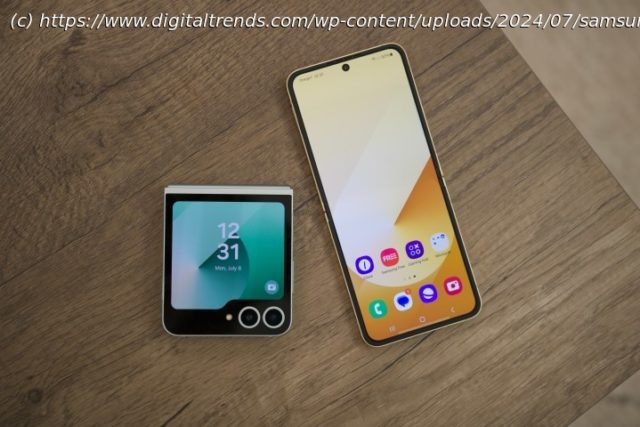The Samsung Galaxy Z Flip 4 was an excellent flip phone when it was released. But now that the Galaxy Z Flip 6 is here, should you upgrade?
Samsung’s latest foldables were far from its best-kept secrets. They were repeatedly spoiled by a barrage of leaks that left barely anything to our imagination. While that may have dampened the excitement for the Samsung Galaxy Z Flip 6 and the Galaxy Z Fold 6, the phones still look promising and feature upgraded designs, better cameras, improved performance, and a sweeping range of AI features.
The Galaxy Z Flip 6 doesn’t offer many significant upgrades compared to the Flip 5. However, if you currently have the Galaxy Z Flip 4 or an older Flip model and are considering an upgrade, the Galaxy Z Flip 6 is worth your attention. We’ll discuss how the Galaxy Z Flip 6 compares to the Flip 4 and help you decide if the larger outer display, improved processor, and enhanced AI capabilities are compelling enough reasons to upgrade.Galaxy Z Flip 6 vs. Galaxy Z Flip 4: specsGalaxy Z Flip 6 vs. Galaxy Z Flip 4: design
The Galaxy Z Flip lineup underwent major design changes with the Galaxy Z Flip 5, and they stayed with the new Flip 6. Most visible changes on the Galaxy Z Flip 6 compared to the Flip 4 include a much larger cover display, which occupies a bigger section of the upper face, and a negligible gap between the folded halves of the phone. The lack of a gap is attributed to a redesigned hinge that anchors the two folding sides together.
When unfolded, the dimensions, thickness, and weight of the Galaxy Z Flip 6 are identical to those of the Flip 5 and the Flip 4. However, after removing the gap lap last year, Samsung has managed to shave 2mm off the thickness in the folded state, making it the thinnest Galaxy Z Flip phone yet. It’s also slimmer than the recently announced Motorola Razr Plus 2024.
Samsung flattened the frame on the sides last year, and not much has changed in that regard, besides the finish being matte rather than glossy. If you are transitioning from the Galaxy Z Flip 4, you might miss the rounder side rails (or you might actually prefer the sharper, flatter ones on the Galaxy Z Flip 6, depending on your preference), as our reviewer did. The Flip 6 also does not include the titanium frame that the Galaxy S24 Ultra received earlier this year.
A minor change now headed to the Flip is the new accent rings around the cameras, now color-coordinated with the color of the phone. Samsung is also offering a wide range of vibrant and dandy case options, called “suit-cases,” some of which even light up like your private positivity-professing billboards.
A significant alteration comes in the form of the newly conferred IP rating. The previous generations of the Galaxy Z Flip came with an IPX8 rating, where the 8 signifies strong resistance to water, and the X suggests that the phone has not been tested for its resistance to dust or fine granular particles. It changes with the Galaxy Z Flip 6, which now features an IP48 rating.
As per the international body that assigns these IP ratings, a solid particle resistance of 4 (on a scale of 0 to 6) indicates the device is safe against solids larger than 1 millimeter in diameter. This still means the phone is susceptible to damage from finer particles of dust or debris (which might get stuck between the fold or under the folding display). However, the level 4 rating adds a sense of assurance that the previous Flips lacked.
Other than these minor design improvements, there is no major change on the outside of the Galaxy Z Flip 6, which leads us to the next aspect — the display.Galaxy Z Flip 6 vs. Galaxy Z Flip 4: display
Similar to the design, which only brings functional improvements instead of radical modifications, the inner display on the Galaxy Z Flip 6 remains largely unchanged from previous generations. The Flip 6 features the same 6.7-inch Full HD+ display we have seen on the Flip 5 and the Flip 4, with features including dynamic refresh rate.
The only noticeable change over previous generations is the inner display’s brightness, now with a whopping value of 2,600 nits for the peak brightness — compared to the relatively unimpressive 1,200 nits on the Flip 4 or 1,600 nits on the Flip 5. This increment ensures significantly better visibility outdoors and richer contrast while watching video content with HDR.
The bigger improvement lies in the cover display, which was upgraded from the tiny and restrictive 1.7-inch section on the Galaxy Z Flip 4 to a much larger square-shaped 3.4-inch display on the Flip 5. The same display carries over to the Flip 6 without any noticeable improvements — and still feels less impressive than the encompassing cover display on the Motorola Razr 2024 series.






